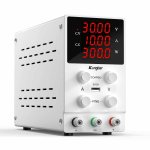tatus1969 said:
Sztef89 said:
Hi! Today is good day to burn... kWeld ;(
I find that I burn Littelfuse SMDJ28A diode and one place. I want replace by myself...
I can't find SMDJ28A to buy local, but I find only (Transil 33V 3kW SMDJ33A DO214AB / LITTELFUSE SMDJ33A-LF).
Can you tell me if this diode will be OK?
The burnt track suggests that the large TVS diodes at the right might be bad as well. These are Littelfuse SLD8S28A. Your replacement parts can't be used as their voltage ratings are too high. Depending on your battery voltage, you can go to lower voltage devices such as SMDJ24A (Digikey has a few of those).
You're right. There is a high chance that the TVS SLD8S28A is also damaged. I think SMDJ24A will be ok, my battery full chage voltage is 6 x 4.2V = 25.2V, this model can support 26.7V, there will be ok

Either way I'm not going to use the kWeld on a full charged battery. I don't want to cause more damage... There is too much power on this Leaf modules...
EDIT paragraph: Today I found diodes to buy locally, model SM8S26A
In the meantime, I did an experiment. I discharged the battery to about 23V (about 3.8V per cell). I installed the SMDJ33A diode and started the calibration. Unfortunately, one SLD8S28A diode has exploded...
Can you tell me if I put everything together well? (Direction and place) Image is below.
I was tired then... maybe I did something wrong during calibration. I still wonder if I held the footswitch long enough... I dont remember offset number... When "Short!" come on LCD then I touched the electrodes and the TVS diode exploded... electrodes slightly melted

I felt like I drank a very strong coffee

I must admit that I can replace burnt components, but I don't know much about electronics and how it all works
 Thanks to you I know that the SMDJ33A diode works with too high voltage (maybe it caused the TVS explosion?). But what if the battery voltage is around 23V, will it work properly?
Thank you for help! I am grateful for your time
Thanks to you I know that the SMDJ33A diode works with too high voltage (maybe it caused the TVS explosion?). But what if the battery voltage is around 23V, will it work properly?
Thank you for help! I am grateful for your time 
:thumb:




